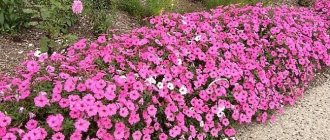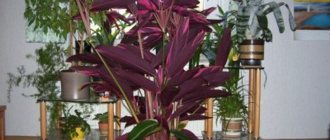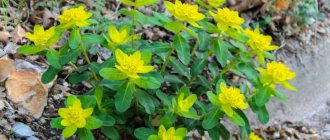What are the differences between bulbous plants?
Bulbous plants can be grown at home, in open ground, in the garden, on alpine hills and in flower beds.
As a rule, bulbs are divided into two types: spring and autumn (according to flowering time). Spring ones are planted in autumn or summer; autumn plants are planted in spring. Spring bulbous plants. Depending on the species, spring bulbs bloom in late winter and finish flowering in early summer. When the flowering season ends, spring bulbs continue to grow, accumulating nutrients and moisture. During periods of drought, spring bulbs may go dormant. These are everyone’s favorite tulips, daffodils, hyacinths, and anemones. Autumn bulbous plants delight with their flowering next season: from the beginning of summer to the end of autumn. These plants are adapted to hot and dry summer weather, but they do not tolerate cold. That is why they are planted in the spring, when there is no longer frost. These include very delicate canna and dahlia, the bulbs of which are recommended to be dug up for the winter.
Bulbous plants in your garden
There is probably no such thing as a summer cottage where bulbous plants do not grow. This is explained not only by their beauty and ease of caring for them, but also by the fact that with the help of bulbous plants you can create new bulbous compositions every year, combining them both with each other, Same with any other plants.
Tulips, crocuses, hyacinths, daffodils... There are a lot of bulbous plants, and they differ not only in the shape of the flowers, the height and color of the petals, but primarily in the time of flowering. Their beauty is that they replace each other throughout the season, and if desired, you can create “flowing” compositions from bulbous plants that are decorative until autumn.
Among bulbous plants there are practically no flowers that are difficult to care for; most of them grow without any problems or difficulties, and the only hassle is periodic planting when they are very thick. In addition, it is advisable to dig up the bulbs of varietal tulips annually so that the flowers do not become small.
We can talk for a very long time about any variety of bulbous plants, from tigridia and muscari to hazel grouse and lilies. They are all different, but they are united by their delicate beauty and ease of care. Almost none of the bulbous plants require complex agricultural technology and, most importantly for our harsh climate, they all easily winter in open ground.
If you choose high-quality planting material (this is the most important thing!) and create compositions with bulbs and primroses in a suitable place for them, they will grow beautifully and delight you for many weeks. But if you show a little imagination, plan out the flower beds and plant flowers in combination with each other, you can create compositions that will be called real art. After all, landscape design, part of which is the creation of flower beds, is creativity!
Blooming in mid-spring
These bulbous plants replace early spring cultivars. They bloom in April - early May. All perennials of this group love open, sunny areas, but grow no less well in semi-shaded places.
Tender anemone
The anemone is about 15 cm high and blooms from mid-April to the first ten days of May. Externally, anemone is similar to chamomile, but has a more interesting palette - it can be snow-white, pale blue, lilac-pink, violet-blue.
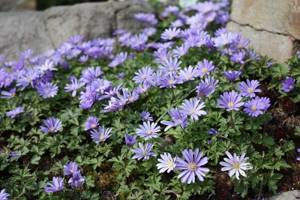
Tender anemone is called anemone
Oriental hyacinth
Decorative representative of bulbous flowers with the largest range of tones (from snow-white to salmon or burgundy-violet). Hyacinth grows up to 20-25 cm and blooms in dense candle-shaped inflorescences consisting of small buds.
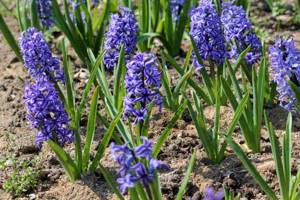
Oriental hyacinth has candle inflorescences
Kandyk, or erythronium
An unusual plant 13-15 cm high, with petals strongly turned back and long pistils. The flowering period occurs at the end of April - beginning of May. The petals are colored soft pink, purple, white or orange-yellow.
Muscari
Other names for the cultivar are mouse hyacinth or viper onion. It grows up to 15 cm and blooms with miniature pyramidal candles. The palette includes all shades of blue and pink. Snow-white muscari are also found.
Narcissus
Thanks to selection, we now know several varieties: small- and large-crowned, tubular, dwarf, double daffodils. The height of the cultivars ranges from 15 to 45 cm, depending on the variety. The color range is also varied.
Imperial hazel grouse, or fritillaria
This original plant blooms in the second half of April and lasts 10-14 days. The length of the erect stem sometimes reaches one and a half meters. The inflorescences are large, drooping, white, lemon-yellow or red-orange in color.
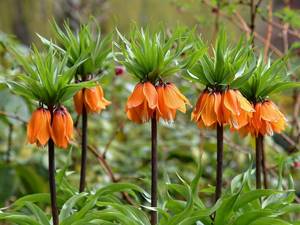
The imperial hazel grouse has a second name - fritillaria
Checkered hazel grouse
A low-growing relative of fritillaria, only 0.2 m high. The drooping buds look like a bell. The petals are lilac-violet, with large snow-white specks. Blooms towards the end of April or early May.
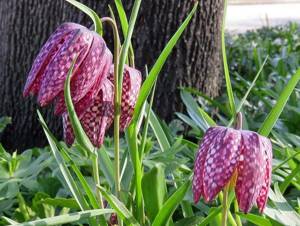
The checkerboard hazel grouse is a low-growing relative of fritillaria
Tulip
The most famous bulbous crop, which is characterized by a variety of varieties and hybrids. Blooming in mid-spring, it blooms for 14-17 days. The height of the cultivars ranges from 10 cm to half a meter. The color and structure of the buds also depends on the species.

Tulip is the most famous bulb crop
Popular bulbs for the garden: top 17
Large-bulbed and corm flowers
Large bulbous and tuberous flowers are the most popular bulbous plants in our gardens. These flowers are quite large in size and require a lot of care. Most often, they begin to bloom in the second half of April and have a long flowering period. The diameter of the bulbs of such crops is more than 3 centimeters.
By the way! For the winter, every autumn you must dig up the following bulbous plants: begonias, gladioli and dahlias. But, for example, lilies, as a rule, can overwinter in open ground.
Gladiolus
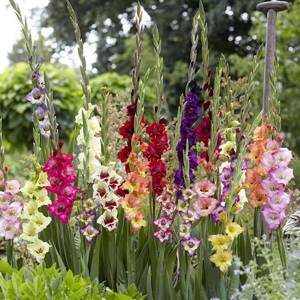
Important! You can find detailed information about growing gladioli at this link , and about digging up and storing its bulbs in winter here .
Lily
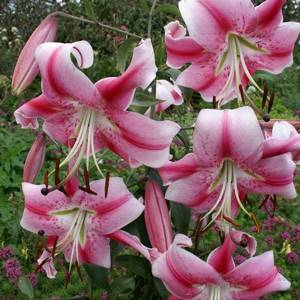
By the way! More detailed information about planting and growing lilies is in the spring , and here in the fall.
Anemone
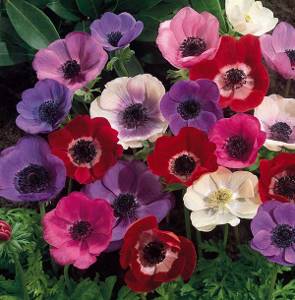
By the way! If you decide to plant anemones , then it will be useful for you to familiarize yourself with all the features of planting and growing these beautiful flowers on your site.
Narcissus
Important! You will find information on when and how to properly plant and grow daffodils in open ground in this material .
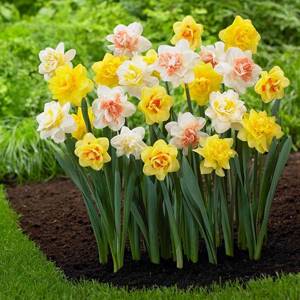
Hyacinth
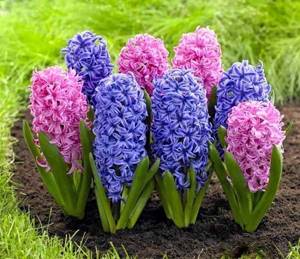
Do not miss! Everything about planting and caring for beautiful hyacinths is described here.
Freesia

Note! how to grow freesia in your garden from this article.
Tulip
Note! You can find out more detailed information about when and how to plant and grow tulips from this material.
Dahlia
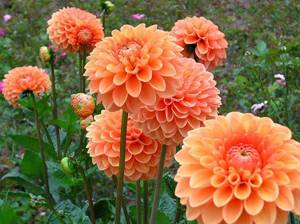
By the way! You can grow annual dahlias from seeds.
Begonia
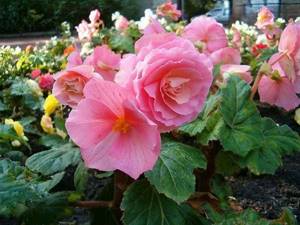
Important! all about growing begonia from seeds and bulbs (tubers) here.
Video: how to plant and replant bulbous plants
Small bulbous flowers for the garden
As a rule, small-bulbous plants are more unpretentious in care. It is advisable to plant them more densely. Once again it is worth repeating the fact that these bulbous flowers, so to speak, get lost in large flower beds. That is why it is better to always plant them in the foreground or among other low-growing plants. They begin to bloom much earlier than others: in fact, as soon as the snow melts on the site (except for Muscari and Ryabchik - only from April). This is explained by the size of the bulbs; small bulbous ones need much less time to awaken. The diameter of the bulbs of such crops is about less than 3 centimeters.
Muscari (mouse hyacinth)
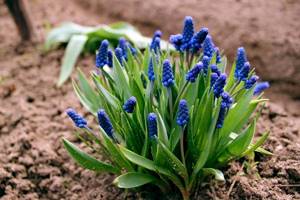
Crocus (saffron)
Important! Information about planting and growing crocuses is presented in this material .
Iris bulbous or reticulate (iridodictium)
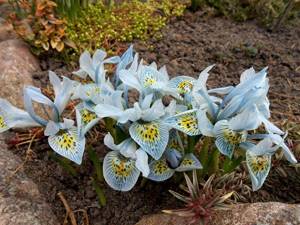
By the way! Read about growing bulbous irises here .
Hazel grouse (fritillaria)
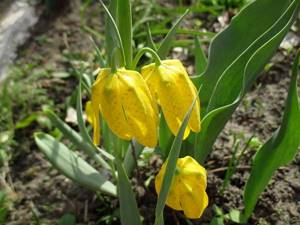
But it is worth noting that the imperial hazel grouse has a very large bulb.
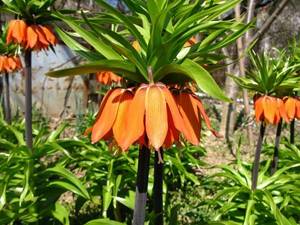
Imperial
Note! Everything about the imperial hazel grouse, its planting and cultivation in open ground.
Decorative bow
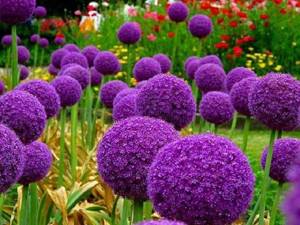
Chionodoxa
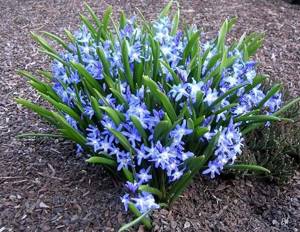
Snowdrop (Galanthus)
Perennial bulbous flowers for the garden: planting features
Bulbous representatives are plants that are grown using small bulbs. There are crops that do not require digging, and there are also species that need to be hidden in the basement for the winter. The ideal time for planting perennial representatives is autumn - late September-early October.
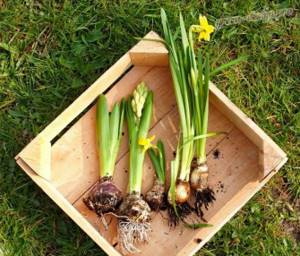
Before planting such crops, you need to carefully dig up the soil and add a little compost. Medium-heavy soils with a drainage layer are considered ideal soils for growing. Gravel, crushed stone or coarse sand are used as drainage. At planting sites, it is recommended to thoroughly compact the soil and trample it with your feet.
To plant perennial bulbous flowers for the garden, you need to carefully prepare the hole. Parameters of 20-25 cm are considered optimal. If the planting material is small, then parameters of 5-10 cm are suitable.
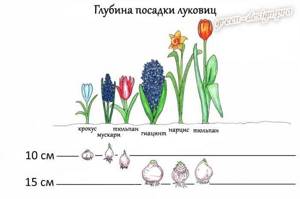
It is recommended to plant large specimens with the bottom facing down, making the distance between the bushes 11 cm. If the weather is very dry during planting, then you can immediately water the crops. This will help accelerate root growth and better wintering of the plantings. The first winter of future plants should take place under a shelter made from peat or old leaves. Further winters do not require an additional protective layer; only mulching can be done.
Rules for growing and caring for garden bulbous flowers
Before breeding bulbs, you need to know the planting rules, which include:
- Thorough digging of the soil and application of specialized mineral fertilizers.
- Depending on the needs of certain plants, you need to adjust the composition of the soil. Some types of bulbous plants do not like overly acidic soil; in this case, you need to add lime.
- In the places where the bulbs will be, you need to add a small amount of sand, and also wait a few days for the soil to settle.
- These types of plants do not like excess moisture. The ideal soil for them would be medium-heavy soil that has excellent water permeability. If the soil for planting is dense, moisture will stagnate in it and the bulbs may rot.
- It is worth remembering that you do not need to add fresh manure to the soil for planting bulbs. In the future, this can lead to the development of fungal diseases.
An important criterion and condition is to observe the timing of sowing bulbs. Flowers that bloom in spring should be planted from late September to early October. Small bulbs such as daffodils are planted first, tulips are planted last. Bulbs, which bloom in summer, are planted in the last days of April and the first days of May.
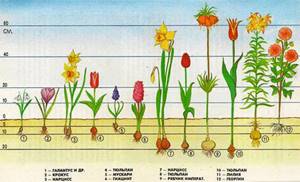
To plant bulbous flowers, holes are dug; they should be two or even three times as deep as the specific type of bulb. The bottom of the dug hole is sprinkled with sand, preferably river sand. The main condition is not to confuse the upper and lower parts of the bulb in places.
Caring for bulbous plants after flowering
Bulbous plants prefer moderate watering and moderate fertilizers. It is better to use mineral fertilizers instead of organic ones. After flowering is completed, yellowed stems must be cut to ground level. Not all bulbous plants need to be dug up, the only exception being tulips, and not all of them. Those tulips that need to be dug up can sit quietly in one place for up to 3 years.
Read more: Tulips have bloomed, what to do
It is necessary to replant nests of bulbs that grow too much and begin to interfere with each other. The feeding area decreases, the flowers begin to become smaller. For those who reproduce quickly, such a need may arise in the 3rd or even 4th year (scrape, muscari, crocus), and in those who reproduce much more slowly, in the 7th year (royal hazel grouse, kandyk).
It is important not to forget about the distance - large diameter bulbs should be planted at a distance of approximately 12-14 cm from each other, and small ones - 5-8 cm. The gap between planted plants largely determines the effect that the gardener wants to achieve. If the weather is dry during planting, the newly planted holes must be watered
This will help the plant take root better. In addition, they overwinter much easier.
Every gardener wants to extend the flowering phase in their area. This can be easily achieved by planting plants on the shady side. When exposed to the sun, many bulbous varieties significantly accelerate their flowering period. Tulips, lilies and crocuses are especially characterized by such properties. That is why you should not plant flowers in an area where there is always sun.
Preparing for winter
When preparing for winter, bulbs are not covered, since they all differ in their winter hardiness. The exception is the year in which they were planted. You shouldn’t overdo it with insulation; a few pieces of spunbond will be enough. And also, you shouldn’t be afraid of frosts in the spring - bulbous plants can tolerate a temperature drop of up to 6 degrees Celsius.
General care rules and important tips
In the paragraph above, we talked about bulbous flowers at home, showed photos and names, and also provided a brief summary of caring for them. However, there are a number of general rules and tips for all bulbous plants. And every novice amateur gardener should know about them.
- Simple but reliable methods. There are a number of whims common to all bulbous plants: love of moisture, love of light, dislike of acidic soil. Also, bulbs often become a tasty morsel for various beetles, mites, fungi, and other parasites. In order not to run around the shops and look for poison (which can also destroy the flower), you can use traditional methods proven by experience. Crushed eggshells and wood ash help reduce soil acidity. To prevent diseases: the same wood ash or ground charcoal.
- Diseases. Even if you decide to get an unpretentious plant from the bulbous family, your pet always has a chance to catch some kind of parasite. We advise all beginning gardeners to regularly inspect the leaves and other parts of their plants. If various unnatural spots, yellowness, or signs of rotting occur, it is necessary to find out the cause and either try to cure the flower or destroy all parts to avoid infection of the entire flower garden.
- Care. And the most important advice is just don’t forget about the living organism that you have tamed and have taken upon yourself to protect it from various diseases and help it grow. In this case, your flower will repay you with the beauty of its bloom and will delight the eye and create a wonderful atmosphere in your home!
Today we found out what kind of home bulbous flower can be planted, we saw photos and names of many exotic bulbous plants. You can find even more information about flowers, planting, soil care, as well as many ideas and drawings of useful homemade products in our garden section. Take care of your “green pets” and enjoy their beautiful blooms every season!
Features and main qualities of bulbous flowers
Bulbous flowers are generally unpretentious in care. But each subspecies has its own characteristics. In order for the growth to be intensive and the plant not to “get sick”, you need to adhere to certain rules and know the preferences of the plants.
There are two seasonal types of flower planting:
- Spring (planted in autumn).
- Autumn (planted in spring).
When planting a tuber in the ground, the correct depth must be taken into account. It makes three identical bulbs.
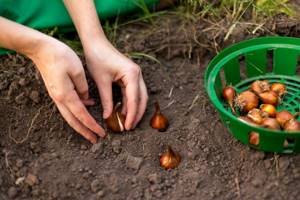
The planting depth of the bulb should be adjusted based on the composition of the soil. On loose soil, the bulbs go deeper over time, but on heavy soil they may not break through too thick a layer of soil.
The tuber should be:
- no cuts;
- without shoots;
- heavy;
- not damaged.
If the bulb still has a shoot, it needs to be planted in the ground as quickly as possible!
Before planting, it is better to soak the bulb in a manganese solution for half an hour.
It often happens that tubers multiply in the ground. A ball forms that needs to be planted. This is done after flowering has ended. They dig up the ball and carefully separate the tubers without damaging them. Then the bulbs are left for storage or planted in the ground.
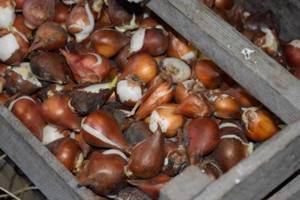
Before storing, the bulbs must be sorted and dried in the shade.
For better flower growth, it is better to use fertilizer. When planting, the bottom of the hole is fertilized and sprinkled with soil, then the tuber is planted.
Try not to let the bulb touch the fertilizer!
Then watering is done. In dry weather in spring, water your flowers generously! Approximately 25 cm deep.
There are two methods of planting bulbs: single or assorted. When planted in groups, vibrant islands of flowers are formed in your area.
The basis and most important thing in an onion is the bottom. A healthy shoot is clean and free of rot.
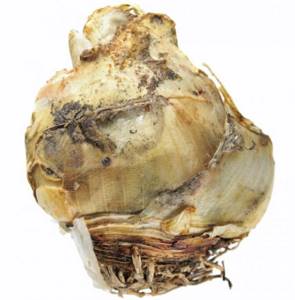
A healthy bulb should not have any damage or rotten areas.
If desired, you can grow the bulbs in winter. They are placed in a pot with soil and placed in a fairly cold underground (cellar). 25-30 days before flowering, the pot is taken to a warm and bright place. Flower bulbs can be grown at home or bought in a store. By purchasing them, you will definitely enjoy their flowering, but whether it will continue depends on the care of the plants.
Bulbs for planting must be purchased in stores from the end of July to September.
Wind, lighting, the presence of other vegetation, height are important factors when choosing planting material in a store.
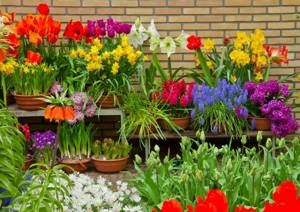
Almost all bulbous flowers can be grown in containers
Features of bulbous indoor plants
Plants that are commonly called bulbous plants are quite diverse, but they all have a bulb, which they need to accumulate nutrients. The leaves extend from the bulb and form a rosette.
Important! For normal growth and flowering they need diffused light.
Most bulbous plants have a clearly defined dormant period. At this time, they shed all their foliage for a while. Some flowers that form a thickened root system retain their foliage throughout the year, but there are very few of them.
Like most indoor flowers, bulbous flowers do not tolerate frost. When the foliage dies, the bulb remains in the flowerpot. During this period, plants are practically not watered and fertilizers are completely excluded. But some flowers, such as cannas, require completely different care in winter. Indoor varieties have perennial bulbs that form more and more flower stalks every year.
You may be interested in: Preserving tulip bulbs to expel them by March 8 On March 8, there are two most popular flowers that are given to women - these are, of course, mimosa and tulips. If...Read more...
Video “Forcing technology”
From the video you will learn how to force house plants.
Bulbous indoor flowers will be a worthy addition to any green collection. But simply purchasing a plant is not enough. You need to know how much watering it needs, how to provide it with optimal lighting, etc. Quite often, novice gardeners can confuse related bulbous plants with each other.
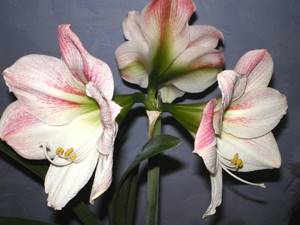
For example, there is an opinion that amarylis is another name for the well-known hippeastrum. In fact, there is very little in common between them; in appearance they somewhat resemble each other, but in all other respects they are completely different indoor flowers.
Amaryllis constantly forms daughter bulbs near itself. The flowers of the plant have very bright, varied shades. Amaryllis blooms once a year, but with proper care you will certainly prolong this process.
House flowers in which the root system is represented by a bulb include wallot. This perennial plant will be part of your home green island for a long time. This flower is characterized by a long peduncle, the flowers on which are collected in an umbrella.
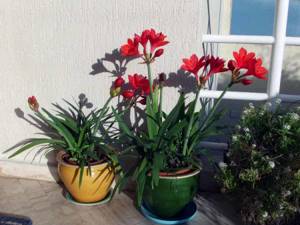
The leaves are long, green with iridescence. Vallota produces red buds. As for the number of peduncles, at the early stage of flower development there is usually only one. But over time, when the bulbous roots get stronger and grow, a pair of such stems may appear from them at once. Caring for wallot is not difficult. The main thing is to protect the flower from direct sunlight; it is better to provide it with access to diffused light.
The flower representatives of bulbous plants also include fragrant hyacinth. It can take root well in the garden, but flower growers often purchase several bright specimens exclusively as house flowers. What is so special about hyacinth? First of all, its flowering, which lasts from December to March
It doesn’t matter how long ago you planted the plant in the pot. If the bulbs are still small, they will produce only one flower stalk, but the colorful flowers on them may not fade for up to three weeks.
Some of them are distinguished by the presence of rather small flowers, but they produce more than one peduncle, so such a plant will not take the last place in your personal rating of indoor pets.
Do you want your home or apartment to be filled with an amazing, intoxicating aroma during the cold winter? In this case, you cannot do without purchasing freesia. This is a low plant that can reach 30-40 cm in height.
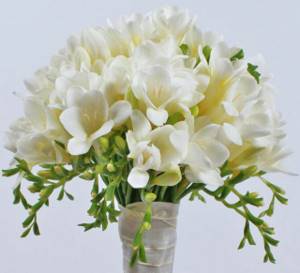
What else is remarkable about freesia is its variety of shades. Your windowsill may be filled with a flower specimen in white, red, pink, yellow, orange and even burgundy shades.
Forcing bulbous plants at home is quite possible if everything is done correctly. Moreover, not only those that we are accustomed to consider as such can serve as indoor flowers. For example, who would have thought that the same daffodils, the harbingers of spring, can be easily grown both as garden and house flowers. In addition, this group includes several different species that take root well indoors.
Hippeastrum
This amazing plant has gained wide popularity among experienced gardeners. In addition, the flower looks very beautiful, especially when the buds bloom. In its appearance, hippeastrum is in no way inferior to even orchids.

In addition, the variety of its colors and shapes of flower petals will allow you to collect a real flower collection on your windowsill. Hippeastrum buds bloom several times a year. However, the frequency and duration of flowering largely depends on the quality of plant care.
Despite the fact that this plant belongs to the bulbous group, its root system is more tuberous than represented by bulbs. Indoor gloriosa can give your interior some zest. This flower has long stems that resemble a vine.
By properly directing the plant, you can decorate your home. And everything would be fine, but the gloriosa tuber can cause serious damage to your health if you did not adhere to basic safety measures during the process of transplanting the plant.
The species diversity of this plant includes hundreds of different specimens, and many of them are consistently grown by gardeners at home.
Crocuses bloom not only in spring, but also in autumn: it all depends on their varieties. Their inflorescences are attractive and fragrant, so they will be a wonderful decoration for any indoor living island. Crocus does not require particularly delicate care; feeding will only be needed during the period of active development and flowering itself.
Ideas for compositions with bulbous plants
There are a huge number of different possibilities for planting bulbous flowers in flower beds - from creating compositions of identical crops in the same color scheme to flower beds that combine a variety of plants and shapes. Let's try to consider the most common compositions with bulbous and primroses, on the basis of which you can vary endlessly number of flower combinations.
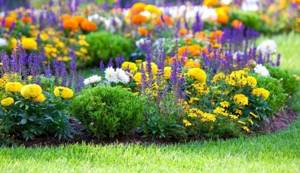
Group plantings on the lawn
The simplest and at the same time extremely effective solution is to plant bulbous plants in groups on the lawn, without combining them with other perennials. If you like natural gardens, this option is sure to suit you.
Imagine that in early spring, immediately after the snow melts, snowdrops, muscari and hazel grouse begin to bloom on your site, gradually replacing each other, and tulips, crocuses, hyacinths and daffodils bloom in the garden. It looks not only very beautiful, but also completely natural, as if you were looking at a flowering meadow.
Moreover, every year the plantings will become more decorative and colorful, because bulbous plants tend to grow.
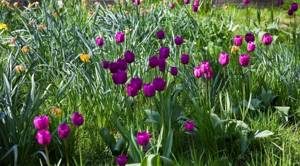
Flower rivers
If you have a stream flowing on your site, then you can create magnificent plantings along it by planting bulbous ones that follow the bends of the riverbed. The same can be done if you have an artificial stream filled with pebbles or small stones.
If you have not yet acquired such elements of landscape design, a “stream” of flowers planted on the site will look great - blue, rapidly growing muscari are best suited for these purposes.

Having made an elongated curved flower bed out of them, even if at first it will be very narrow, after a few years you will not recognize the “bed” - bright flowers will fill the planting and create the effect of a running river.
Of course, you can use a variety of shades of these wonderful spring flowers. You can line the “bed” with large boulders on the sides, and this will give the composition even more naturalness.
Floral mix on borders
A great idea is to make bright borders from bulbs. They will look great, for example, along paths in the garden, framing them in the form of bright, beautiful ribbons. You can plant plants of the same color and type, or combine completely different ones.
A similar frame can be made near the fence, in the front garden, at the front porch of the house, near the gazebo - wherever you want to add beauty and decorativeness.

Just try not to plant flowers that do not require annual digging of bulbs in compositions of bulbous plants next to tulips, otherwise their root system will be permanently damaged as a result of manipulations with planting material. No plant will thrive if its roots are constantly disturbed.
Container growing
A great solution for a small garden or patio, terrace or outbuilding is to grow bulbs in containers. Not only does such a solution greatly simplify the care of flowers - fading plants can simply be removed to the far corners of the garden, brought indoors for the winter, changed places, constantly choosing new decorative solutions - plants in containers look doubly interesting thanks to the beautiful containers in which they are planted.
However, lovers of this design should take into account that, despite all the convenience, plants in containers require increased attention - they will have to be watered and fertilized much more often due to the limited space for roots.

If you planted your bulbous plants in open ground, they will feel great without watering, and you don’t need to add fertilizer to the soil, at least not often. But when growing flowers in pots, you simply cannot do without these procedures. Both watering and fertilizing must be provided. “Sticking an onion in the ground and forgetting about it” will not work.
If you absolutely do not have time to care for flowers in containers, we can recommend the so-called “bottom watering”. The pots are simply placed in trays with water, diluting a little liquid fertilizer for flowering plants in it. The flowers themselves take as much moisture as they need through the holes in the pots, and you will not have any problems with care.
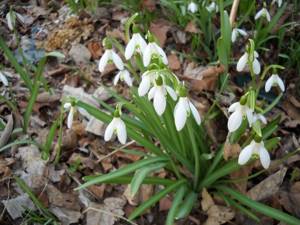
Of course, crushed stone or special stones should be placed at the bottom of the pots for drainage - this will help the bulbs not to become waterlogged.
Useful tips and tricks
If you are determined to start growing tuberous or bulbous flowers at home, then you should take on board some useful tips and recommendations for their care and maintenance.
To plant bulbous indoor flowers, only good clay pots with thin walls are suitable. With the onset of the plant's dormant period, it will be necessary to either reduce watering or stop it altogether. When the planting is in an active stage of growth, on the contrary, it must be watered regularly. A high level of humidity has to be addressed when it comes to forcing flowers in a greenhouse. When watering indoor plants of the types considered, it is recommended to use the bottom watering method. In this way, it will be possible to avoid unnecessary waterlogging of the soil and rotting of the bulbs. In both the case of bulbous and tuberous flowers, one must not forget about the drainage layer in the pot where they will be planted. Some indoor plants, such as the bulbous perennial Weltheimia, are susceptible to fungal diseases. These are serious illnesses that can affect a flower and its “neighbors”. Plantings with such problems require only moderate watering. Overwatering can be dangerous. Always keep your green pets' health under control
If you notice that your potted plants don't look good and are clearly sick, there's no time to waste. It is necessary to determine as soon as possible what the cause of the problems that have arisen is, and then begin to solve them.
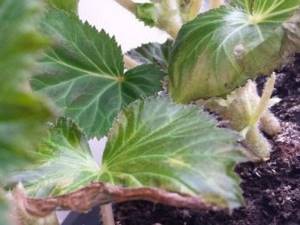
It can be very difficult for a novice gardener to understand what contributed to the development of a particular disease, so in case of doubts or questions, it is better to consult with a more experienced person who is well versed in such issues.
Sources
- https://ogorod-bez-hlopot.ru/lukovicnye-komnatnye-rastenia.html
- https://yan-dir.ru/lukovichnye-komnatnye-rasteniya.html
- https://doma-v-sadu.ru/komnatnye-rasteniya/lukovichnye.html
- https://agronomva.ru/lukovichnye-komnatnye-rasteniya/
- https://stroy-podskazka.ru/komnatnye-cvety/lukovichnye-i-klubnevye/
- https://podokonnik.temadnya.com/1476104878896973943/lukovichnye-komnatnye-tsvety-s-nazvaniyami-i-foto/
Tall indoor plants
Hybrid canna is a colorful, eye-catching, fairly large plant up to one meter in height. Each stem produces large flowers that can be purple, red, yellow, cream, orange or pink. Canna's oblong leaves can be light green, dark green, bronze-red, purple-tinged brown, or striped. With age, three or four shoots may appear from one corm.
Hippeastrum has a rather large bulb, the diameter of which can reach 11 cm. From one to six large funnel-shaped flowers are formed on each stem. Flowering most often occurs in spring and winter, but can sometimes bloom in summer. The most common types of hyperastrum include:
- Hippeastrum striped is distinguished by a median keel with red-lilac stripes and elongated ovoid white petals, between the edges of which there is a longitudinal stripe.
- Hippeastrum graceful is a plant whose height can be from 45 to 70 cm. Large funnel-shaped greenish-white or whitish-yellow flowers are formed in January and in May or June.
- Hippeastrum reticulum is a stem 30-50 cm high. Lanceolate leaves and a peduncle with 3-5 buds sprout from a small bulb. The crimson-red petals have numerous dark veins.
- Hippeastrum reginas is distinguished by linear-lanceolate leaves and perianth with a red funnel-shaped tube and a whitish-green pattern in the throat.
- Hippeastrum Leopolda is a plant with a strong, two-flowered stem. Flowers up to 18 cm in diameter are white at the top and red in the middle.
Amaryllis is very similar to hippeatum, but has an incomplete peduncle, blooms only once a year in the fall and regularly produces daughter bulbs. Amaryllis grow up to 50-70 cm in height. Each stem produces 8–12 large pink-red flowers. Three or four plants can be planted in one pot at once. With proper care, a flower can exist for many years.
Wallota belongs to the amaryllis family. It has reddish, dark green, linear leaves at the base. The length of each leaf reaches 65 cm and the width is 3.5 cm. An umbrella with flowers of salmon, white or bright red color is formed on a long stem. After it fades, there is no need to immediately pick off the flowers. You should wait until the flower stalks dry and then trim them.
Eucharis (see photo) can also be classified as a tall flower. The second name is Amazonian lily. This beautiful plant resembles a daffodil. Its snow-white, fragrant, umbrella-shaped flowers appear in October and bloom until winter. Eucharis then goes dormant in March and blooms again in the spring. On one long stem of eucharis, 50 cm high, three flowers are formed at once.
Indoor bulbous plants
Exotic plants that are not adapted to the harsh climate are grown in apartments and winter gardens. Among them are bulbous indoor plants.
Additional Information! At home they also keep garden crops. They do a special forcing so that they have time to bloom in time for the spring holiday.
Most suitable for home keeping:
- Since ancient times, Hippeastrum from the Amaryllis family has won the love of flower growers with its huge, showy flowers. Currently, varieties with yellow, orange and green flowers have been developed. These bulbous house flowers also have double forms. Hippeastrum requires direct sunlight, watering with slight drying of the soil. At the end of summer they stop watering it. Aboveground shoots dry out. The container is transferred to a dark place. In mid-winter they begin to water. And after about a month the plant blooms.
- Eucharis has wide, slightly elongated leaves and white flowers, reaching up to 12 cm in diameter. This bulbous flower is called the Amazon lily. The plant does not require complete rest, like hippeastrum. After flowering, the leaves do not dry out. Grows well on a window with diffused light. Willingly responds to feeding. During the flowering period, watering is increased.
- Zephyranthes is a typical representative of bulbous plants at home. Very delicate flowers in white, yellow and pink. It is preferable to grow several pieces in a pot: this creates the effect of mass flowering.
- Bulbous indoor flowers "Upstart" love bright sun and moderate watering. Conditions during the dormant period are similar to caring for hippeastrum. The plant rests all autumn. The first flowers appear in April.
- Valotta purpurea belongs to the Amaryllis family. A distinctive feature is the bright purple bases of the leaves. Flowers are red and crimson. An unpretentious plant that loves bright light and moderate watering. From February to April is a period of rest.
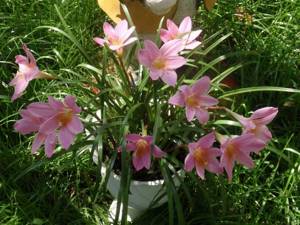
Zephyranthes
List of the most popular plants with photos
Bulbous and perennial primroses are the very first flowers in your garden in the spring. In cold regions, the snow has not yet had time to melt, and they, having raised their petals, are already reaching for the sun. If you successfully integrate bulbous primroses into the design of your flower bed, they will delight the eye every year.
Did you know? Catholics in Spain and Italy consider the lily to be the flower of the Blessed Virgin, and the image of the Mother of God is often framed with a wreath of these flowers.
Garden
Consider the list of the most popular bulbous flowers for the garden:
- Snowdrop. This flower grows one of the first and literally from under the snow. Snowdrops can withstand temperatures as low as -10°C.

Babiana is a flower from the Iris family. From the bulb grow narrow lanceolate sword-shaped leaves 15 cm long, which also have bristly pubescence.
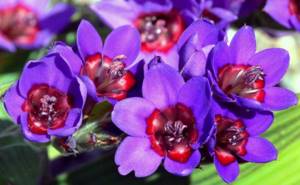
Colchicum - also known as colchium, is a perennial plant. There are about 70 species in the genus of this flower.
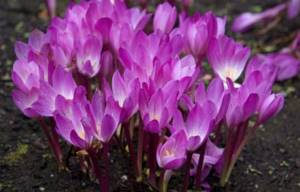
Gabranthus (rain lily) - has airy petals that justify the name of the flower, meaning “delicate flower” in Greek.
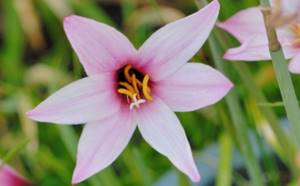
Gladiolus is a corm-like perennial flower, of which there are more than 5,000 species. There are hybrid and wild gladioli. They delight in their beauty and variety of colors.
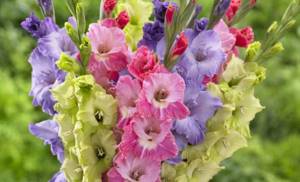
Oriental lily - these flowers are valued for their large flowers (more than 20 cm in diameter) and varied colors.
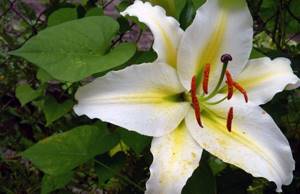
Lily LA-hybrid - obtained by breeding Asiatic and long-flowered lilies. This flower is distinguished by its endurance, decorativeness and unpretentiousness.
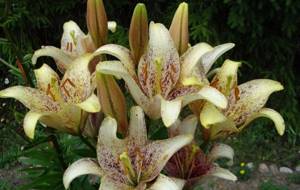
Lily OT-hybrid - the plant was obtained by crossing trumpet and oriental lilies. They reach a height of 1–1.5 m or even higher, under favorable conditions.
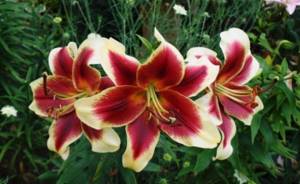
Narcissus has been a very popular flower since ancient times. There are many varieties of daffodil, and all of them are highly valued by gardeners for their incredible beauty.
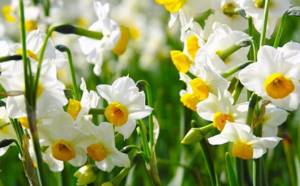
Tulip - the birthplace of this plant is Central Asia, despite the fact that most tulips grow in Holland. In recent years, more than 3,500 types of tulips of various shapes and colors have been bred.
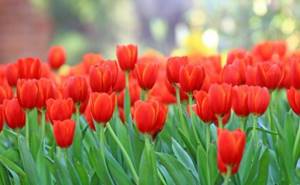
Indoor
The following are bulbous indoor plants (with photos and names) with which you can decorate your home:
- Hybrid freesia is a very beautiful plant with funnel-shaped flowers on one side of a strong peduncle up to 50 cm high. It has a strong fragrant odor.
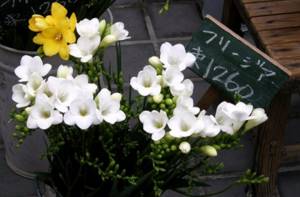
Hymenocallis is pleasant - it blooms with fragrant flowers in late spring, peduncles reach a height of 60 cm. It is very similar to a daffodil with narrow and long petals.
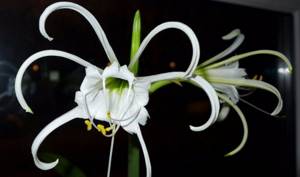
Hippeastrum hybrid - has hollow stems, on which there are inflorescences of 3-5 flowers. Hybrid varieties have many types, colors and shapes.

Zephyranthes grandiflora - forms peduncles up to 15 cm high, blooms in early summer with flowers very similar to crocuses.
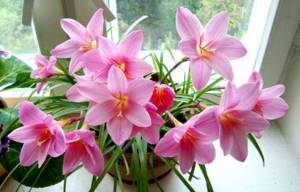
Weltheimia cape is great as a houseplant. A peduncle up to 30 cm high, with about 60 bell-shaped flowers, will decorate any home.

When planting bulbous plants at home, it is very important to pay attention to the choice of pot. A container made of lightly fired clay, which has thin, porous walls, is best suited. The inside of the pot should not be glazed
The size of the pot is selected according to the size of the bulb
The inside of the pot should not be glazed. The size of the pot is selected according to the size of the bulb.
Important! The pot is selected correctly when the distance from its walls to the bulb is 1.5 cm of free space. There should be a drain hole at the bottom of the container
The diameter of the pot should be the same as its height
There should be a drain hole at the bottom of the container. The diameter of the pot should be the same as its height.
Garden broadleaf bulbous plants
Typical representatives: Foster's tulip, canna, colchicum, chionodoxa.
Foster's Tulip is 25 cm high and 10 cm wide. Green or glaucous, leaves with slight pubescence on the upper side. Care is typical for tulips.
Chionodoxa
A low plant – 12 cm, broadly lanceolate leaves. Blooms with single flowers or racemes. Flowers are up to 4 cm in diameter. The corolla is colored white, pink, blue and blue.
Features of cultivation:
- Lighting – sun, partial shade.
- Loose, fertile soil.
- The plant is winter-hardy.
- During the flowering period, it requires regular watering. If the snow has not melted yet, then watering is not needed.
Colchicum Byzantine
Tall flower - up to 60 cm. Leaves - 30 cm long and 10-15 cm wide. The flowers are white or purple, double, more than 10 cm in diameter. Blooms in August.
Note! One bulb can produce up to 12 flower shoots per season.
Features of cultivation:
- Colchicum prefers sun to partial shade.
- If there is no drought, then the plant does not require watering.
- The soil is drained, without stagnant water.
- A transplant is recommended after 4 years.
- It is recommended to mulch the soil.
Colchicum
Plants that require special living conditions
In pursuit of growing large inflorescences, breeders do not always take into account the degree of stem thickness. And many new bulb varieties have huge flowers but thin stems. This, of course, looks gorgeous in a flowerbed when the weather is warm and calm. But if during the flowering season there is a rainy season or a strong wind rises, all the beauty will instantly fall to the ground, because the thin stem will not withstand the swinging or the wet, heavy inflorescence. This situation can occur with many varieties of double daffodils and freesias.
Latest entries Indoor plants that can bloom into trouble Why is it dangerous to plant “mother-in-law’s tongue” on your windowsill Folk ways to acidify the soil and thereby increase its fertility
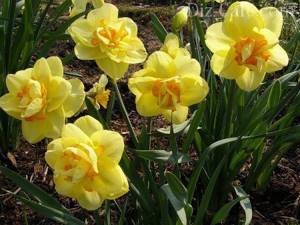
The more petals in the inflorescence of a double narcissus, the faster it gets wet and puts its weight on the thin flower arrow
Gladioli often break, but not because the stem is weak. On the contrary, a powerful flower arrow with an abundance of large inflorescences becomes a heavy burden for the bulb. And it is at the point where the stem begins to grow that breaking occurs during windy weather. Therefore, many plants with tall stems will have to be tied up as soon as flower stalks begin to appear. You can, of course, immediately plant bulbous plants near a net or fence, but such a place is not available in every area. By the way, a very close “relative” of the gladiolus – acidanthera – is absolutely not afraid of the winds. However, only one flower produces.



